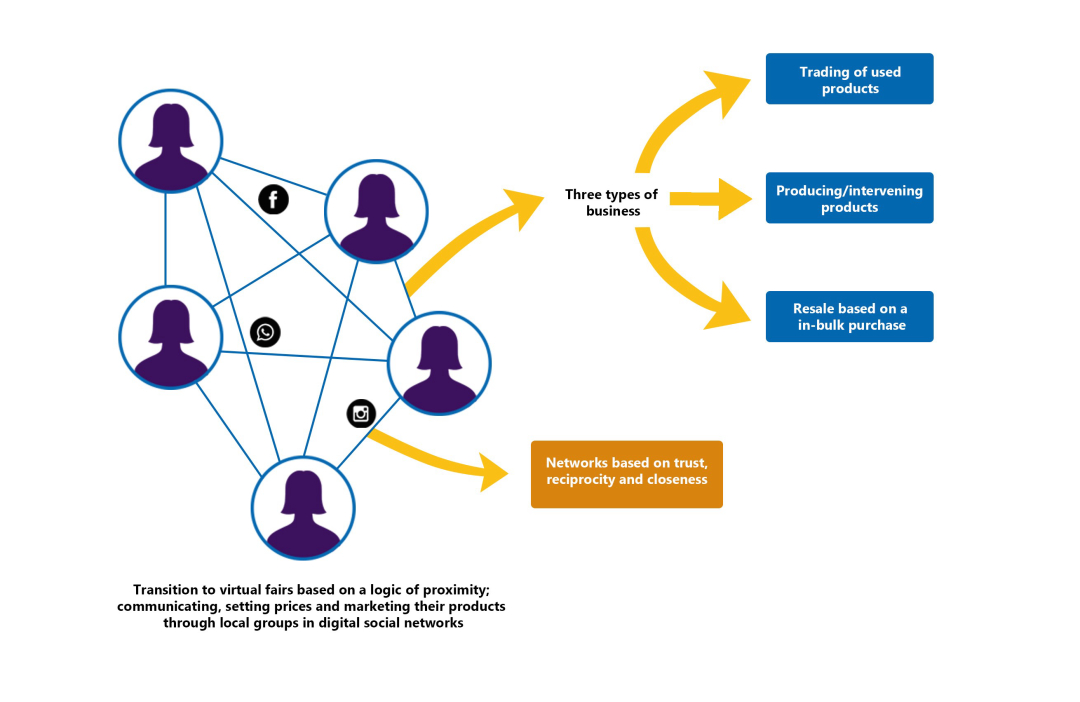During the pandemic, the mandatory isolation measures underscored the weakness of small shopkeepers and/or producers’ marketing channels. This situation was aggravated by the closure of “non-essential” businesses and the ban on public meetings and/or mobility in public spaces, which made open-air fairs and street selling impossible. Faced with this scenario, people continued their economic activities through the virtual space in different ways. The UNPD Argentina Accelerator Lab (Co_Lab) was able to identify these new strategies through our work in the territories illustrated in the report “Shared search: CoLaborative solutions mapping”, which was carried out in the middle of the quarantine period. The first solution identified during this fieldwork was how informal ways of trading such as open-air fairs or barters became “virtual” through social media, allowing money to circulate, which is fundamental in terms of economic recovery. This form did not involve charging commissions on sales, but it did come with new considerations on how to work better (photo quality, product descriptions, live streaming, etc.). In turn, participation in a virtual fair group also involves agreeing on ways of exchange. Based on the interaction with potential customers, an agreement is made on payment methods, either in cash or by digital means, and delivery methods, carried out through a delivery system or a street meeting to complete the transaction. One of the main characteristics of this type of fair is maintaining the proximity of the market, that is, between buyers and sellers, since most of them are restricted to a neighborhood or local space. WhatsApp, Facebook, or Instagram groups indicate the neighborhood or town to which they belong to avoid transactions with high shipping costs or, as one neighbor pointed out, to “sell to your own neighbors whom you already know.” In other words, the mapping showed that this type of fair maintains its neighborhood spirit even in the virtual world. They act as digital marketplaces where the products offered are posted with photos and detailed descriptions on WhatsApp or Facebook groups. It is a widely used strategy to market local products and services, and for exchange or barter. If neighbors want to join a WhatsApp group, they must request access to someone they know. In Co_Lab’s most recent mapping “Mujeres en Red” (Women in Network), it was possible to observe that this solution usage was very extended among women from low-income neighborhoods, understood as a solution linked to women’s economic autonomy. In this context, 3 versions of the solution could be identified: ● Trading of secondhand products: Women identify and select some of their belongings at home that they no longer use and can be sold. They check the conditions of the products, wash them, and organize them for sale. ● Producing and/or intervening products: Women use their knowledge to design, prepare, cook, knit/sew. In any of these cases, an initial purchase of material is needed. ● Resale: It entails a previous in-bulk purchase, which requires investing capital beforehand. This could be linens, cloths, cleaning supplies, etc. Women select what to buy, where, how much and, depending on the product, how to fraction it. The virtualization of local commercial relations at no extra cost was made possible by the wide-spread access to cell phones with internet connection and digital means of payments. The testimonies gathered from interviews with women shed light on this solution: “It started with the pandemic, people started to sell things and use WhatsApp groups… the one who sells pastries, secondhand clothes, cleaning supplies. A girl living around the corner said: ‘I’m going to set up a WhatsApp group’. Now there are more than 100 of us. It started with only 4 blocks, and the girl started receiving comments such as: ‘Can you add my cousin?’. And now it gets all the way to the train station that is more than 30 blocks away. They set up meeting points halfway, so you move and I move. It expanded and expanded. Now there are a lot of them (WhatsApp groups) in the neighborhoods, 2 or 3 that are very big […] You add most of the contacts you make so later on you get to see them through their WhatsApp statuses”. Interview #29, adult woman, from “Mujeres en red: soluciones financieras y de recuperación socioeconómica” (Women in Network: Financial and Socioeconomic Recovery Solutions). Once products are published for sale, prices are set at a value that is accessible to the virtual community in which they are operating. Many times, the possibility of barter is also stated. These offers can be seen in a WhatsApp status, a Facebook live transmission, or Instagram stories. Most of the time, the items for sale are seen by a close circle of friends, relatives, or neighbors, though these Facebook lives or Instagram stories can reach a bigger market that may include strangers, but always inside this local logic of word-of-mouth commercialization. Above all, recreating the “fair” in the virtual world implies improving social media skills, developing digital marketing capabilities, and using different audiovisual resources to “promote” products and gain market share. Some of the reasons for women to choose this type of solution are: ● It mobilizes resources they already have at their disposal: their cell phones, internet connection, products they don’t use anymore, digital social networks, community networks, among other things. ● It transforms digital social networks into their workspace: they are no longer used only for entertainment or communication purposes. The pandemic accelerated their usage to build a work agenda and the corresponding content dissemination. ● It allowed to maintain a certain level of economic activity through commercialization, community logic, and local bonds. ● It allows for the same income as a daily informal job. ● It allows women to be present at home taking care of children, elders, or people with disabilities. ● It boosts community and collaboration. Apart from the “virtual” fair, digital social networks continued to be used after mobility restrictions were eased. When WhatsApp or Facebook closed buying and selling groups evolved into a local in-person fair, a solution of a permanent working space with digital channels appeared. Women choose this solution for the same reasons previously mentioned, and above all, because the possibility of having a physical space that facilitates communication and dissemination of information on local dynamics adds value for these entrepreneurs. In these spaces, neighbors can find out about new economic activities, public policies, and social programs. They can also share experiences from the pandemic and help each other to deal with digital procedures (see “Informal Intermediation of Digital Procedures Solution). The connection with the digital sphere manifests itself, for example, when raffles take place and the event is transmitted online for those who could not attend, or to share special offers with regular customers. To install oneself in this fair, it is important to have enough capital to invest in furniture such as trestles, boards, or blankets. It is also useful to have previous selling experience. When one of these local businesses grows enough through the help of social digital networks, the opportunity to move to a commercial facility appears. This means to have a physical store and support from an online one. Capital, time and long-time planning are needed for this type of project, but there is an expectation for stable employment and income associated with these small family businesses. Finally, other alternatives identified in our mapping campaigns were virtual stores on the internet and catalog advance sales. The first ones are alternative websites, with formal operating rules, for the digital sale of products made by popular, social, and solidarity-based economy and/or family farming enterprises. Their main characteristic is that products are developed by civil society organizations or academic centers; this enables the sharing of knowledge and technical resources necessary to develop them. On the other hand, sales by catalog allow entrepreneurs or heads of household to sell their products in advance through a digital catalog shared on social media or WhatsApp, at a much lower cost than those currently available on the market. Unlike other alternatives, this type of solution allows individuals to generate income without prior resources. In all these solutions, the movement of goods and services at affordable prices is one of the main factors creating expectations among consumers who participate in these types of exchange networks. At the same time, they allow the movement of secondhand and new products, and offer great flexibility in terms of payment methods by incorporating electronic means, but also by allowing face-to-face transactions to close the deal on some occasions. Finally, the bonds of trust, reciprocity, and closeness are factors that also explain the power of this type of solution in a context of crisis. Trust in this type of network and its participants (whether sellers or consumers) is key to guarantee a commercial exchange.

https://www.undp.org/es/argentina/publications/mujeres-en-red-soluciones-financieras-y-de-recuperacion-socioeconomica
https://www.undp.org/es/argentina/publications/busqueda-compartida-mapeo-de-soluciones-colaborativo-inclusion-financiera-y-recuperacion-economica
https://www.undp.org/es/argentina/publications/de-cerca-inclusion-financiera-y-soluciones-territoriales
 Consent to share form or official link.
Consent to share form or official link.

 8Decent work and economic growth
8Decent work and economic growth 9Industry, innovation and infrastructure
9Industry, innovation and infrastructure 10Reduced innequalities
10Reduced innequalities 17Partnerships for the goals
17Partnerships for the goals
Comments
Log in to add a comment or reply.